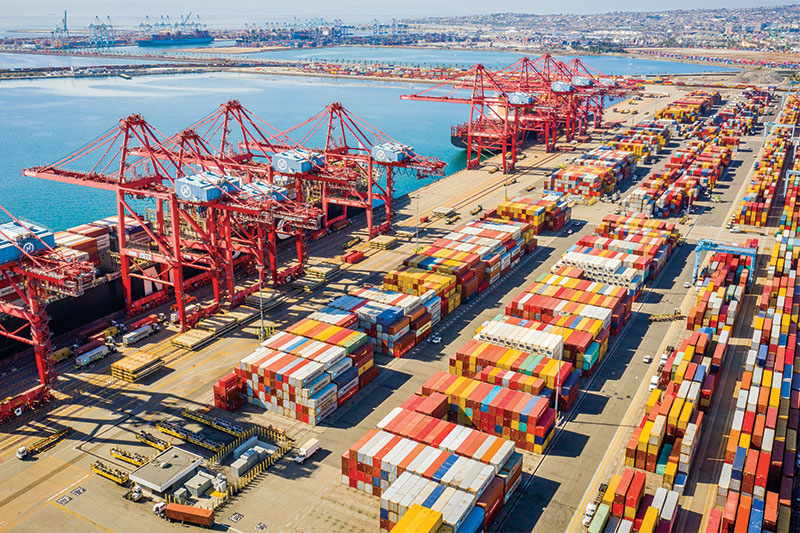POLA and POLB report April volume declines
April volumes at the Port of Los Angeles (POLA) and the Port of Long Beach (POLB) saw annual declines, according to data recently issued by each port.
Total POLA volume—at 688,110 TEU (Twenty-Foot Equivalent Units) fell 22% compared to April 2022, which marked the second highest-volume month on record for POLA.
POLA imports fell 25% annually, to 343,689 TEU, and exports were down 12%, to 88,202 TEU. Empty containers saw a 23% annual decline, coming in at 256,220 TEU.
While volumes declined annually, April marked the second straight month of sequential improvements, with March volumes up 28% over February and April volumes up 10% over March. And on a year-to-date basis, total POLA volume—at 2,525,204 TEU—is down 29% compared to the same period a year ago, which represented the highest-volume four-month start to a year for POLA.
POLA Executive Director Gene Seroka said on a media conference call yesterday that he is optimistic the sequential improvements will continue, with POLA projected to reach or exceed 700,000 TEU in May.
“Undoubtedly, it has been a challenging year so far,” said Seroka. “That said, we have the capacity and are ready for more throughput in the months ahead. The issues are play are clear.
First, we have a cooling global economy along with U.S. concerns about lingering inflation and rising interest rates. Second, warehouses remain laden with ageing inventory across the country. And third, we have the prolonged West Coast labor negotiations weighing on the marketplace.”
Addressing the economy, he explained POLA is seeing mixed signals, with no clear consensus on what lies ahead, noting that Maersk, one of the largest ocean carriers calling on POLA has tempered expectations for the year, coupled with the National Retail Federation 2023 retail sales outlook is viewed as cautious.
“The high demand for goods witnessed over the last few years has softened,” he said. “On the other hand, the U.S. had a strong jobs report, and both freight and energy costs are stabilizing. Aside from the debt ceiling showdown, which must be resolved without a government default. We are also keeping a very close eye on the Federal Reserve meeting in mid-June. The Fed’s next move on interest rates will be an important factor in determining where the economy and trade are headed for the rest of the year. Second, with respect to inventory levels, the replenishment cycle has yet to kick in. Once we see a reduction in warehouse surpluses, there will be opportunities for increased import levels, which, so far, have been relatively stagnant.”
As for the West Coast port labor negotiations between the Pacific Maritime Association and the International Longshore and Warehouse Union, Seroka said he believes that the parties are on the doorstep of a tentative agreement.
“Both sides are spending a lot of time at the negotiating table, and I'm optimistic we'll hear good news soon. A tentative agreement would be a welcome development for customers who have been diverting cargo elsewhere, and resolving this issue will send us a clear signal of stability. Overall, I am optimistic we'll see a better second half of the year. If economic conditions improve and we get a labor deal in place, that will definitely help drive our volume here in Los Angeles. Yet, even with economic uncertainty, I expect improvement compared to the first half of the year. Bottom line as I've mentioned earlier, we're prepared for the next cargo surge whenever it comes.”
POLB data: The Port of Long Beach reported that total April volume—at 656,049 TEU—was down 20.1% compared to April 2022, the port’s highest-volume April on record. Imports were down 21.8% annually, to 313,444 TEU, and exports eked out a 0.6% annual gain, to 122,663 TEU.
Empty containers were off 26.2%, to 219,943 TEU. Port officials pointed to consumers continuing to limit purchases, with shippers moving cargo from West Coast ports to East and Gulf Coast ports as factors for the annual decline.
On a year-to-date basis through April, POLB volume is down 27.5% compared to the same period last year, at 2,377,375 TEU.
“The unprecedented consumer demand we saw at the height of COVID-19 has diminished and cargo flows are now closer to pre-pandemic levels,” said Port of Long Beach Executive Director Mario Cordero in a statement. “We expect slow growth in the second half of 2023, as retailers continue to clear surplus inventory from their warehouses.”













